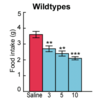(gastro) appetite Flashcards
how does the body control thirst? (3)
- increase in plasma osmolality
- reduction in blood volume
- reduction in blood pressure
which is the most potent stimulus for thirst control and how?
plasma osmolality increase is the more potent stimulus
= change of 2-3% induces a strong desire to drink
how do changes in plasma osmolality compare to changes in blood volume and arterial pressure?
plasma osmolality = needs to increase by 2-3% maximum to induce strong thirst
but decreases of 10-15% are required in blood volume or arterial pressure to have the same effect
which hormone is responsible for the regulation of osmolality?
ADH (anti-diuretic hormone)
(i.e. vasopressin)
what is ADH and what is it alternatively known as?
anti-diuretic hormone
= alternatively known as vasopressin
where does ADH act in the kidney?
acts on the basolateral membrane of the renal collecting duct cells
(specifically, the V2 receptors)
what is the function of ADH?
regulates the volume and osmolality of urine by stimulating water reabsorption from the renal collecting duct, back into the systemic circulation
= concentrating the urine

what happens as a result of low plasma ADH?
a large volume of urine is excreted (water diuresis)
what happens as a result of high plasma ADH?
a small volume of urine is excreted (anti-diuresis)
where is ADH stored?
posterior pituitary gland
what is water diuresis and when does it occur?
when the plasma ADH levels are low, less water reabsorption occurs so larger volumes of more dilute urine are produced
what is anti-diuresis and when does it occur?
when the plasma ADH levels are high, more water reabsorption occurs so smaller volumes of more concentrated urine are produced
how is the osmolality of the plasma detected?
osmoreceptors (sensory receptors) on the surface of the neurones of the hypothalamus
= detect changes in plasma osmolality
what are osmoreceptors?
sensory receptors that detect changes in plasma osmolality
where are osmoreceptors found?
found on the surface of specific hypothalamic neurones
(in the OVLT, SFO of the hypothalamus)

what are osmoreceptors responsible for?
osmoregulation
= altering ADH secretion into the systemic circulation to either increase or decrease water reabsorption
which two hypothalamic regions contain osmoreceptors?
OVLT (organum vasculosum of the lamina terminalis)
SFO (subfornical organ)

which of the two hypothalamic osmoreceptor regions has a greater effect?
OVLT (organum vasculosum of the lamina terminalis)
explain the process by which osmoreceptors regulate ADH release in a hypertonic environment
hypertonic solution (more concentrated than the intracellular fluid)
= cell shrinkage (as water moves out of the cell via osmosis)
= increased proportion of active cation channels
= increase influx of positive charge
= depolarisation
= increased action potential firing frequency
= increased signals to ADH releasing neurones
= increased ADH secretion
= stimulates fluid retention and invokes drinking

explain the process by which osmoreceptors regulate ADH release in a hypotonic environment
hypotonic solution (less concentrated than the intracellular fluid)
= cell expansion (as water moves into the cell via osmosis)
= reduced proportion of active cation channels
= reduced influx of positive charge
= hyperpolarisation
= reduced action potential firing frequency
= reduced signals to ADH releasing neurones
= reduced ADH secretion
= increased fluid loss
how does the neuronal response differ in a hypertonic environment compared to that of a hypotonic environment?
in a hypertonic environment = cell shrinkage leads to depolarisation and increases stimulation of ADH secretion
in a hypotonic environment = cell expansion leads to hyperpolarisation and decreases stimulation of ADH secretion
when the plasma osmolality is increased, how do the neurones respond?
neurones shrink and the proportion of active cation channels in the membrane increases

why does the proportion of active cation channels increase when plasma osmolality is high?
a hypertonic solution stimulates the movement of water out of the neurone, causing neuronal cell shrinkage
= increases the number of active cation channels in the membrane

how does ADH secretion increase when plasma osmolality is high?
increased plasma osmolality
= cell shrinkage
= increased number of active cation channels in the neuronal membrane
= depolarisation
= increased firing rate to stimulate increased ADH secretion


































